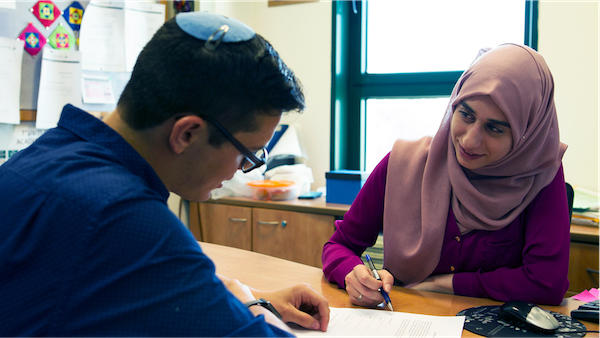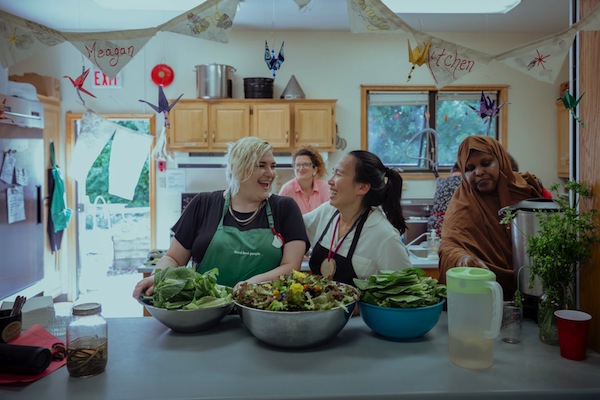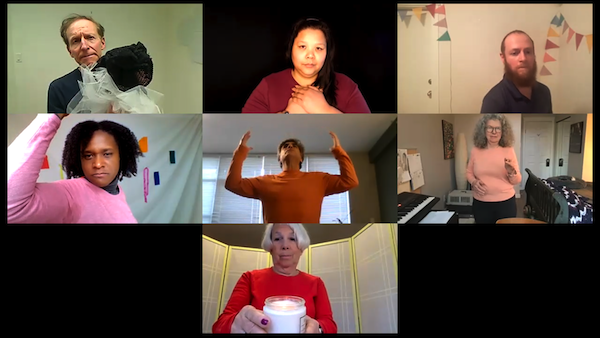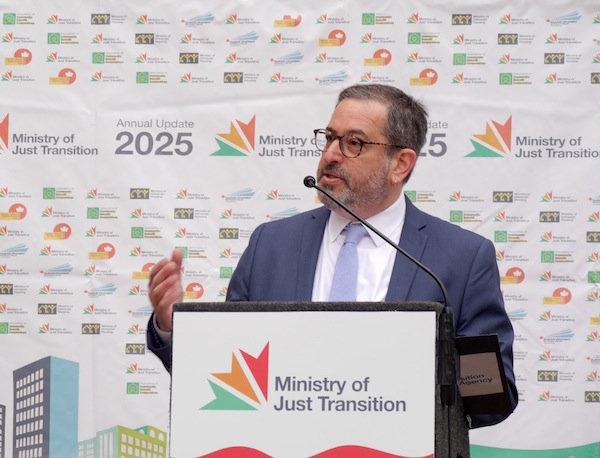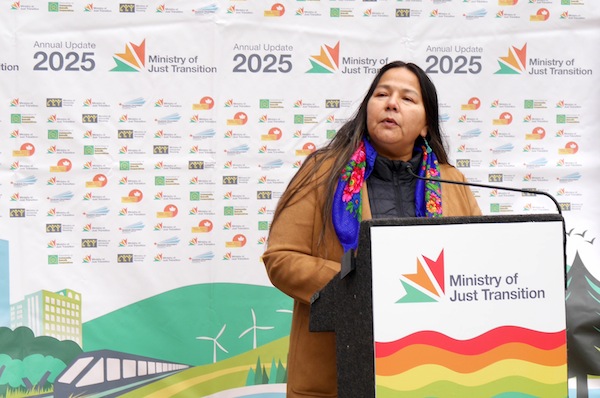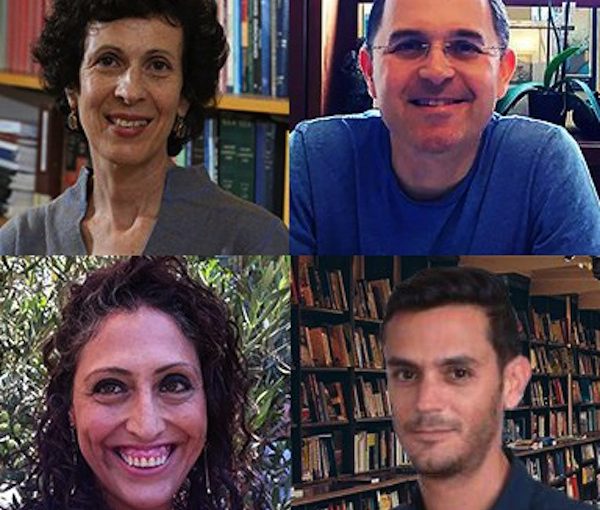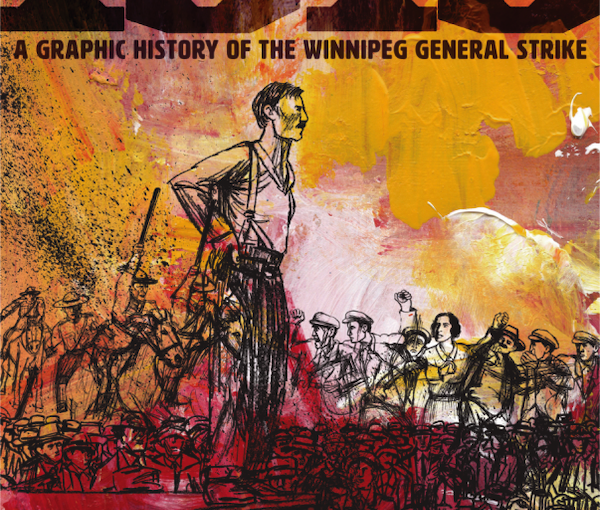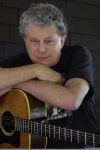Si Kahn plays at the folk festival, which runs July 13-16. (photo from sikahn.com)
While Charlotte, N.C.-based folk musician Si Kahn – who’s coming to play at the Vancouver Folk Music Festival next week – may have called the United States home for most of his 73 years, he spent about 12 of his first 16 months of life in Canada. His father, Rabbi Benjamin Kahn, was sent to Montreal by B’nai B’rith in 1944 to help set up the Hillel Foundation at McGill University, which he did for just over a year before being called back to Pennsylvania State University.
“I like to say that I don’t have a single negative memory of my time in Montreal,” said Kahn, whose father eventually became the international director of B’nai B’rith Hillel Foundation (1959-1971).
And Kahn’s Canada cred goes back further.
“After my paternal grandfather, Gabriel Kahn, deserted the czar’s army and walked across Europe, he was a pick-and-shovel labourer for the Canadian Pacific Railway, helping build the ‘northern spur’ through the [Canadian] Shield towards Timmins,” Kahn told the Independent. “He was also a hod carrier in Winnipeg, helping build the Royal Alexandra Hotel, carrying 100 pounds of bricks or mortar up 10 or more storeys on his shoulders.”
Kahn tells his grandfather’s story – and that of many other members of his family – in the musical Hope. The song “Crossing the Border” highlights the border-crossings of his grandfather’s journey from Russia: “He got passage to Nova Scotia / Got married in Manitoba … Then he moved down south of the border / By the mills on the Merrimack River / He pumped gas and kept store for a living / Raised up his daughter and sons.”
Gabriel and his wife, Celia, settled in Lowell, Mass., said Kahn, who wrote about his Jewish roots and their influence on his music in an article called “The Chords that Bind.”
“When I was growing up … our family sang together,” he writes. “On the Sabbath and on holidays, we would stay at the dinner table long after the food and dishes had been cleared, and we would sing. Because musical instruments were not allowed on the Sabbath, we sang without instrumentation – but not without accompaniment.”
From his paternal grandfather, he learned “the fine points of creating a rhythm section, using only two basic variations (closed fist and open palm) of the basic hand-on-table technique.” From his parents, he and his sister, Jenette – whose career in the comic book industry included being president of DC Comics for more than 20 years – learned “the rudiments of high and low harmony, made up as you go along.”
The songs they sang were mostly prayers. “We sang a little bit in Yiddish, too, folk and story songs from the Old Country, which in this case meant almost any place in Europe,” he notes. And, despite his not understanding most of what he was singing, he did understand “what the songs really meant to us as Jews, as a family, as people in the world. They were our bond, our unity, our affirmation, our courage. They were our way of claiming our rhythmic and harmonic relation with each other and with our community. Our songs reinforced our solidarity, our sense that we could overcome the obstacles in our path.”
As for when his musical career began, Kahn told the Independent, “You might say I ‘turned professional’ in 1974. I had just turned 30 years old a few months before I recorded my first album, an LP titled New Wood, which was released in 1975 on June Appal Records.
“One of my first paid public performances was in 1979 … at the second-ever Vancouver Folk Music Festival. I’d led traditional labour and civil rights songs at rallies and demonstrations and on picket lines, but Vancouver was one of the first times I played my own original songs in public.
“While I do consider myself a professional musician, and while I’m a longtime member of the American Federation of Musicians (AFM), music has always been a very part-time vocation for me. My lifetime identity and work since I was 21 years old has been as a civil rights, labour and community organizer.
“I once told a reporter that my music is ‘a hobby that got out of hand.’ That’s really an accurate description. I typically do no more than three festivals and a dozen concerts each year at most. Most of my appearances are benefits for progressive nonprofits,” he said, adding that he’d be performing at the Vancouver Folk Music Festival house-party fundraiser on July 12.
Kahn heads to Orillia, Ont., for a July 7 performance at the Mariposa Folk Festival. From there, he’ll come to Vancouver for the folk festival, but also “to do some organizing work for Musicians United to Protect Bristol Bay.” It’s a cause he’s been helping on a volunteer basis since 2010 – the campaign’s goal is “to stop the Pebble Mine, and to protect permanently Alaska’s Bristol Bay, a cultural and environmental treasure, and one of the world’s last remaining great wild salmon fisheries.” He has donated all of the income from his 18th CD, called Bristol Bay, to the musicians’ group.
About combining music with activism, Kahn said, “The defining moment for me came when I was working with the Student Nonviolent Coordinating Committee (SNCC) on the Arkansas side of the Mississippi River Delta in the summer of 1965, when I was 21 years old, during the Southern Civil Rights Movement, which was very much a singing movement. That was when I first began to understand the usefulness of music in movements for social justice.”
Among Kahn’s many achievements in the social justice arena was being, in the early 1980s, an initial organizer and the founding national board chair for the Jewish Fund for Justice, the predecessor to Bend the Arc: A Jewish Partnership for Justice. He has written three books on community organizing.
“I see myself as an organizer, which I consider a specific type of activism, rather than as an activist,” he explained. “Organizers work to bring people together so that they can use the power of numbers to counter the power of money, authority and/or force.
“In any organizing campaign, in any campaign for justice, there will be competing sets of ‘facts.’ Whether our facts are more accurate/truthful than their facts isn’t nearly as important as whether, through organizing, we can build enough collective power to persuade those who have the ability to make the change, or changes, we’re asking for to meet our demands.”
On the topic of truth, Kahn said, “For me, there’s a difference between accuracy and truthfulness. Take, for example, the story of Moses receiving the Ten Commandments on Mount Sinai. Is that story accurate in the literal sense? But it should be told and retold truthfully, meaning that it’s our responsibility to transmit the story as it was told to us, whether verbally or in written form.
“My question is whether, in the real world, it’s even possible to differentiate,” he said. “If someone believes something passionately, it’s more than likely that no amount of either ‘facts’ or ‘alternative facts’ is going to persuade them to change their mind.
“Minds are more likely to be changed by experience. One of an organizer’s roles is to help the people she/he is working with have experiences through which they achieve a sense of possibility, that the world might be different for them and for others like them.
“This is also one of the places where storytelling can be useful. Years ago, I was in an audience listening to former U.S. senator Paul Simon. I don’t recall the specifics but, at one point, he was challenged on his support for legislation concerned with disability rights. He could have answered with facts/statistics (or, for that matter, with ‘alternative facts’). Instead, he said, ‘Let me tell you about a young man I know,’ and proceeded from there.”
In the musical Hope, there is a song called “Dreamers,” the chorus of which calls for us to “honour the dreamers.”
“I consider myself a ‘practical radical,’ someone who helps people work towards what at least appear – based on careful analysis and strategic thinking – to be achievable goals,” said Kahn. “If that’s being a dreamer, dayenu.
“There are many things I’d like to see in this world we share that I just don’t see as possible. I may be wrong in that judgment. But, if I’m going to help people organize themselves in order to achieve a goal they share, I need to believe there’s at least one and hopefully several practical paths to achieving that goal.
“The ‘dreamers’ I honour are those who not only have a dream, but who do everything they can to make it real.”
For the Vancouver Folk Music Festival’s 25th anniversary, Kahn wrote the song “For Canada,” which recalls the Underground Railway, the slaves making their dangerous way here: “When all hope was failing, think what strength it gave / To dream about a country that no longer held a slave….” A country to which, “… my own father’s father came with willing hands / To bend his back and lay the track across this wild land….”
And it was on his way home (by car) from his 1979 festival appearance that Kahn wrote “Plains of Canada,” the lyrics of which show his affection for the country – an affection that endures.
And so, too, does his love of singing and performing.
“Vancouver resident Josh Dunson, who was my agent for over 30 years until his retirement from the music business, once told me that what I bring to my musical performances is my many years’ experience as an organizer. That’s a very perceptive observation and a good description of what I try to do in the musical part of my life and work,” said Kahn. “When I’m planning a concert, when I’m on stage, I’m doing my best to help those who are listening feel that they’re not so much a passive audience but active participants. Sometimes this means singing along, sometimes it means thinking about what they’re hearing and applying it to their own lives and their own work. It’s that possibility that still excites me even after all these years.”
This year’s folk festival, once again at Jericho Beach, starts with a free concert the night of July 13, and then there are day and weekend passes that can be purchased for the performances July 14-16. For tickets and the full schedule, visit thefestival.bc.ca.

